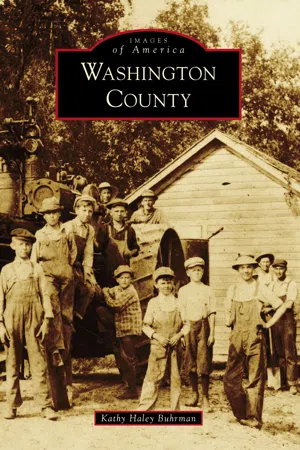![]()
One
RIVER TOWNS
TAKING A GAMBLE ON
PUSHING THE FRONTIER
The early towns in Washington County were river towns along the Missouri River, established during the steamboat era before the railroad was built west of the Missouri. Fort Calhoun, DeSoto, and Cuming City were established along the river. Fontanelle (a misspelling that was never corrected) was a territorial town overlooking the Elkhorn River on the western edge of the county but had no river traffic. People, livestock, and necessary provisions arrived by steamboat, flatboat ferry, the occasional canoe, on horse-and-wagon teams, and sometimes by foot. In the summer of 1854, after the Nebraska Territory was opened for settlement, the first permanent settlement in Washington County was established two miles west of the original fort, and the name Fort Calhoun was adopted. On December 25, 1854, acting territorial governor Thomas B. Cuming appointed Thomas J. Allen, one of the first pioneers to settle in Washington County, as the first territorial sheriff of the county.
Fort Calhoun was the county seat and held that position until 1858, when a crowd of armed DeSoto citizens took the county seat by force. In 1866, by popular vote, it was again moved to Fort Calhoun. In 1869, the county seat was moved to the newly formed railroad town of Blair, where it has remained.
Fontanelle, a village of some 200 settlers, was incorporated and became the county seat of Dodge County, in which Fontanelle was then located, in March 1855. Fontanelle remained the county seat of Dodge County until January 12, 1860, when the western boundary of Washington County was redefined and extended to the west side of the Elkhorn River.
After the departure of the Engineer Cantonment expedition in 1820, the site was abandoned and the exact location lost. In 2002, archeologists discovered the location and excavation began. Building ruins, lead balls, a smoking pipe, ceramic pieces, and other artifacts of early 19th-century living began to emerge. In 2015, it was listed in the National Register of Historic Places. (Courtesy the Nebraska Historical Society.)
As master of ceremonies, William Henry Woods, Washington County’s first historian, leads the 1919 centennial parade of Fort Atkinson. Born in England in 1839, Woods emigrated to America as a boy. A recognized archeologist, he studied and excavated the grounds of the fort, discovering valuable bones of prehistoric animals, Indian relics, and the remains of soldiers in the cornfields (once the site of Fort Atkinson). Through Woods’s tireless efforts over the next 55 years, the history of the fort and the site of the Lewis and Clark expedition were preserved for future generations. Well known in and instrumental in preserving the history of his adopted community, Woods had a wish that Fort Atkinson be recognized as a national cemetery for the soldiers buried there. He died in 1927 and is buried in the Fort Calhoun Cemetery.
Fort Atkinson was the first military post west of the Missouri, with troops numbering over 1,100. The soldiers protected the fur traders but spent most of their time hunting, fishing, and farming. In 1827, the garrison transferred to a new camp at Jefferson Barracks in Missouri and the fort was abandoned.
In 1971, the Nebraska Game and Parks Commission began reconstructing the fort. Today, Fort Atkinson is a Nebraska State Historical Park and a National Historic Landmark. In 2003, a life-size bronze depiction of the Lewis and Clark historic meeting was installed on the grounds of Fort Atkinson. The bronze men were sculptured by artist Oreland C. Joe.
Fort Calhoun was claimed as a company town in 1854. In 1855, Elam H. Clark surveyed and platted the town into lots, and 100 lithographs were printed to advertise the rising settlement. In 1856, Fort Calhoun was incorporated and Elam Clark was mayor. Some of the early settlers in Fort Calhoun and the county were the Allen brothers and the Craig, Beale, Rohwer, and Arnold families.
A company cabin was built on the site of the old fort, in which to administer laws in the fledgling settlement. The first district court proceeding in the county was in June 1855, involving a case of claim jumping, common throughout the West in the early settlements. A courthouse constructed of logs and cottonwood boards was built in 1856 (pictured). It also served as the first church and school.
In 1854, a post road was constructed using old Indian trails. As communities settled, Fort Calhoun became a stopping point along the road. The Tew hotel, later known as the Worline Hotel, was originally a four-room log house of cottonwood built in 1856, for travelers to rest and dine. The hotel was one of the best-known hotels in the early West for many years. It was torn down in 1937.
In 1858, the Fort Calhoun flouring mills were put in operation by Z. Vanier & Brothers. Th...








